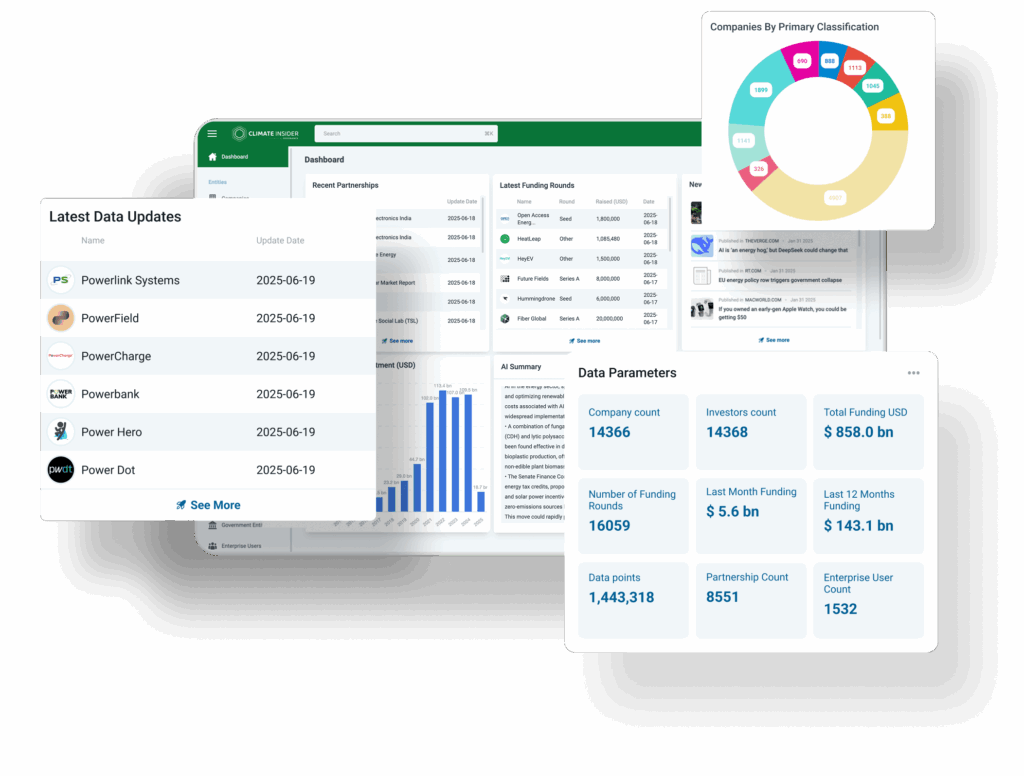From An Inconvenient Truth to Greta Thunberg, the topic of climate change has long lost its air of novelty. A heatwave here, a harrowing study there; on the surface, it might appear as if the climate’s rapid decline has been accepted as the new norm. But underneath, things are shifting. As CO2 levels spike and the effects of the spiraling climate are beginning to make themselves felt, people (and, in turn, many governments and companies) are becoming increasingly concerned, and efforts to fight it are underway.
Much of the battle lies on the shoulders of technology, charged with the Sisyphean task of decarbonizing the global economy. Urged on by consumer pressure and governmental incentives, companies and startups focused on emissions mitigations – called climate tech – are growing. Now, however, they have their most critical mission yet: ensuring that it’s here to stay.
The Current State of Climate Technology
Since it needs to decarbonize pretty much the entire world, climate tech is a fragmented field. In some sectors, it’s already a booming business; it’s helped along by growing consumer pressure on companies and governments coupled with governmental incentives like the US’s Inflation Reduction Act (IRA), which grants businesses juicy tax cuts for climate-friendly practices.
Renewable energy is one such flourishing industry, accounting for some 30% of the world’s energy consumption. Though this is far off what’s needed to meet climate goals set out in the 2015 Paris Accords, the fact that renewable energy finally became cheaper than fossil fuels in the last few years means that its share is likely to grow. Electric Vehicles (EVs) have become a similarly thriving sector since market leader Tesla popularized the technology over the last two decades. Now, countless car companies are racing to develop their own electric models, and EVs made up 18% of all cars sold in 2023 (up from just 2% in 2018). These climate tech trends are especially pronounced in China; the country produces 80-90% of the world’s solar cells, 60% of wind turbines, and 58% of electric cars (every third new car sold in China is an EV). Largely thanks to these two sectors, the International Energy Agency estimates that 80% of emissions reductions needed by 2030 to keep up with net-zero goals could be achieved with existing technologies.

The key word here is ‘can’ – it’s by no means a guarantee. Indeed, a report by PwC indicates that the world must decarbonize seven times faster to reach net zero by 2050, and research by the IMF suggests that current climate commitments would fall short of 2030 targets. It’s not hard to guess why; even with existing technology, reaching these would require a revamping of entire energy grids, not to mention the overhaul of several major industries, meaning trillions in investment and pushback from incumbent polluters. And then there’s the missing 20% of tech needed to reach 2030 targets; the number rises to 35% for 2050 goals. It likely includes what’s needed to decarbonize the heaviest polluters of them all: industrials (manufacturing, mining, resource management) and construction. According to another report by PwC, investment in these sectors’ climate tech startups, who are responsible for much of the innovation, is lagging behind. To make things more complicated, the report notes that the climate tech industry tends to be ‘buzzy and trend-driven’, rife with innovations that are impossible to scale. So to get back on track with climate targets, the industry’s current trends revolve around robust business models that provide perks beyond merely saving the world. These could be making existing processes more efficient, saving on costs, greenwashing for marketing, or helping with tax cuts laid out in the IRA.
Read also: Top 10 Wind Energy Companies & Startups in 2025
4 Climate Tech Trends & Innovations In 2025
Climate Tech Trend #1: Integrating Renewable Energy
The heavily saturated renewables industry is doing just fine on its own but can face challenges when it comes to integrating its output into the energy grid and everyday life. Renewable energy doesn’t always mesh well with current grids, as detailed by McKinsey; not only does its rise coincide with higher demand for electricity partially due to other climate tech (like EVs), but its sources produce electricity intermittently, making it hard to plan around and avoid outages. Now that renewables are often cheaper than fossil fuels, there’s a bigger focus on making this process smoother.
Renewable Energy Innovations
- Load shifting: adjusting the source of the energy depending on cost, grid load, and availability of renewables. While it’s not a new process, renewables’ growing share of electricity means that better grid flexibility is direly needed. Companies developing such systems include Renew Home, Reel, Stem, and solar panels manufacturer Enpal.
- Batteries for renewables: a way to bunker renewable energy so it can be used when supply is low (like when solar panels stop producing at night). This is one of the most well-to-do investment magnets in the sector, and its predicted rise mirrors that of renewable energy (according to SVB). Providers include Antora Energy, Form Energy, and Field Energy.
- Off-the-shelf solar panels: installing solar panels on the buildings that use them, like a home or offices. This reduces reliance on the grid for externally sourced renewables. The trend isn’t technically new either, but global solar capacity surged by 50% in 2023. Here, almost all leading companies hail from China; the frontrunners include Tongwei, JA Solar, Longi, Trina Solar, and Yingli Solar.
Read also: Top 5 Renewable Energy Startups in 2025
Climate Tech Trend #2: Decarbonizing Industry and Construction
Renewables and EVs might be the most mature sectors in climate tech, but the stinkiest polluters are by far construction and/or industry; though exact classifications and estimates vary, this sector contributes up to 38% of global emissions. Funding for startups developing abatement tech had a small jump in 2023 (according to PwC), but it’s by no means proportional to the damage it does. Still, a few promising technologies are gaining ground.
Decarbonizing Innovations
- Green hydrogen: powering the production of hydrogen – a versatile fuel or feedstock for various industrial processes – via renewable energy. Usually, this process is fueled by natural gas and releases CO2 as a byproduct. Green hydrogen uses a process called electrolysis (wherein an electrical current separates splits water into oxygen and hydrogen), which can run entirely on renewables. Electrolyzers are complex beasts, making them expensive and tricky to scale. But while many corporations have invested in it, only a few companies claim to have cracked the price issue, including Electric Hydrogen, Matteco, and Verdagy.
- Green cement: revamping the production process of cement to negate its environmental impact. About 8% of CO2 emissions come from cement production alone (as reported by Forbes), owed both to the coal used to heat the limestone and the CO2 released by it. According to SVB, green cement has snapped up slightly more investment in 2024 than green chemicals, which usually hoovers up the biggest chunk. One of the sector’s success stories is Fortera, which captures the CO2 released during cement production and repurposes it to create green cement.
Read also: 15 Green Tech Companies & Startups in 2025
Climate Tech Trend #3: Emissions Tracking and Minimization
Tracking emissions and reshuffling polluting processes to minimize them isn’t easy, but if you’re a company, it could save you money in the form of tax credits and less wasted material – plus, it looks really good in an advertisement. It’s therefore unsurprising that companies selling software designed to track clients’ environmental footprint have been seeing success recently. Others specialize in recycling customers’ refuse or helping them cut down on waste.
Emission Innovations
- Carbon accounting: tracking a company’s (or person’s) activities to pinpoint its emissions or other environmental faux-pas and suggesting ways to mitigate them. The concept has been around since the consultancy firm Carbon Trust was founded in 2001, but more companies have joined the club recently, developing software that can go through mountains of data much faster than a human. They include Persefoni, Greenly, and – most recently – Microsoft Cloud for Sustainability.
- Circular economy: a buzz term describing reusing, repurposing, recycling, and avoiding waste wherever possible. Several companies have developed new ways of tracking and minimizing specific kinds of waste. Winnow, for example, specializes in reducing food waste, Li-Cycle recycles batteries, and Enerkem converts waste into biofuels.
Climate Tech Trend #4: Carbon Capture and Removal
It’s often criticized as a cop-out for polluters, but capturing and removing carbon is set to play an integral part in long-term climate change mitigation (according to a report by State of CDR). Right now, trees take care of most of it, but given the increase in forest fires due to climate change, they run the risk of releasing the carbon back out again; plus, research shows that Earth’s capacity to absorb carbon is weakening. Venture capitalists sank $17.8 billion into the sector in 2023 compared to $2 billion in 2018 (according to Pitchbook), and McKinsey suggests it’ll snag $100 to $400 billion in investment by 2030. Most importantly, as cataloged by SVB, planned capture and removal projects’ estimated emissions mitigations fall just under what’s needed for net zero.
Carbon Capture Innovations
- New methods of carbon capture: capturing carbon from the atmosphere or the factories it originates from isn’t anything new. But thanks to the carbon offsets or credit market (in the US, boosted by the IRA), new ways of capturing it from the environment and removing it from the cycle are constantly popping up. This might include catching biomass before it decomposes or catches fire (Graphyte), grabbing carbon from the air via sponge-like rocks (Heirloom), or filtering it out from ocean water (Captura).
- New methods of carbon utilization: as an alternative to storing it underground or underwater, captured carbon can be given a second life. Some of it eventually reenters the atmosphere after being used as synthetic fuel, making the latter a net-zero emissions technology. But to banish the carbon from the cycle forever, it must be banished forever – perhaps encapsulated in CarbonCure’s concrete or Air Company’s perfume.
Read also: Top 5 Carbon Capture Startups in 2025
Key Challenges in Adopting Climate Tech Trends
As it’s rife with brand-spanking new technologies, much of climate tech is not immune to its woes: long development timelines, lots of untested tech, and truckloads of cash needed to get going. Plus, many of the sector’s technologies are difficult to scale, such as green hydrogen; only companies like Electric Hydrogen, who are developing simple, standardized, and relatively cheap plants, are beginning to show promise. There’s also the quibble of legacy infrastructure and processes – like, for example, the energy grid – not evolving quickly enough to allow climate tech to get a foot in the door. If that weren’t enough, the world is already lagging behind net-zero timelines, showing that despite the generally healthy business side of things, it might still be lacking the sense of urgency needed to keep up with the climate trends.
Also, the sector’s importance to consumers, governments, and the climate itself causes it to be surrounded by a constant buzz of hype. A decade ago, this overexcitement – coupled with a few other factors – caused climate tech’s cousin cleantech to go bust. Today’s industry is more restrained, but the caution of investors juxtaposed again the urgency of the climate situation causes it to be in a constant state of tension. But while the sector seems more robust now than it did when cleantech went bust, it’s still a young industry. Many of the things it has going for it hang on political incentives, and these shouldn’t be taken for granted (the IRA, invaluable to US climate tech companies and its corporate clients, could, in theory, be killed if US elections swing that way).
Read also: Top 6 Clean Tech Companies & Startups in 2025
Which Trends Are Impacting Innovations The Most?
Naturally, the biggest trend driving innovations in climate tech is, well, the climate. When it first became a topic of international debate in the 1990s, the effects of human activity on it weren’t nearly as obvious as they are now; today, many people need only step outside to feel its growing toll. As its role in popular discourse grew – through science, media coverage, and activism – so did public concern.
The fat cats of fossil fuels tried to fight it for a while, but after governments and global organizations like the UN got involved and set measurable targets, penalties, and incentives, it was clear that the jig was up. Of course, it didn’t stop them from producing fossil fuels, but they did start investing in climate tech too. This wasn’t just out of a love for the climate; the tax breaks and subsidies (in the US and China, respectively) were juicy, and climate tech – especially renewable energy – could reach fossil-fuel-levels of market growth. Now, according to Grace Sai, Co-Founder and CEO at Unravel Carbon, ‘92% of the world’s GDP has made net-zero pledges in the last decade’ (as reported by Forbes), and studies show that the overwhelming majority of people are concerned about climate change; this creates a whole new target market of companies, governments, and even individuals who want to reduce their carbon footprint, which was not the case twenty years ago.
These trends – public concern, governmental action, corporate interest, plus more advanced technology – are driving today’s climate tech innovation. In turn, they influence what’s prioritized in the industry; for example, corporate interest in carbon capture or removal – an easy way for companies to claim credits and present a green image without changing their practices – is a considerable contributing factor to the technology’s popularity.
What Climate Tech Trends & Innovations to Expect in the Future?
Based on recent research by the International Monetary Fund and PwC, progress in climate tech isn’t happening quickly enough to adhere to net-zero goals; meanwhile, research by SVB shows that many startups lack funding. But that doesn’t mean it’ll go bust like Cleantech did. As the PwC report suggests, the climate tech sector is in a state of transition; mature technologies like solar, wind, and EVs no longer need venture funding, and investment for novel tech designed for the heavily polluting industries is just picking up. And in the US, where most venture capital investments are made, the incentives established by the IRA are only two years old.
Therefore, as renewables and EVs become increasingly integrated into everyday life, the future of climate tech innovations will likely be in hard-to-abate sectors like industrials and construction as well as carbon capture, even though these haven’t quite picked up yet. Disrupting the market with these, the SVB report notes, could take years; turning a profit might be even longer, and becoming integrated in everyday life longer still. So the race is on for climate tech to revolutionize the most polluting sectors before the planet becomes uninhabitable – but not too quickly, because as we saw with cleantech, ‘deep tech takes time’ (as noted by SVB).
But as the world waits, its condition is deteriorating. It’s impossible to say what exact climate trends will develop in response, or whether they’ll stand the test of time – but above all, climate tech must prove that it in itself is more than a mere trend. Climate change certainly isn’t.








